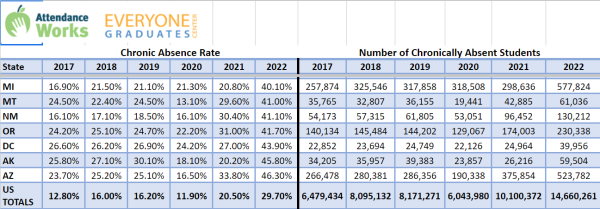Imagine a classroom where a quarter of the students are missing on any given day. This scenario is becoming all too common as school absenteeism has emerged as a critical issue affecting students, families, and communities. As absences become more frequent, it’s crucial to understand their reasons, whether health-related, familial issues, or challenges within the school environment.
To fully grasp today’s attendance problems, we must also consider how COVID-19 and the 2020 lockdown worsened the situation by introducing new obstacles.
2020 was hectic and catastrophic, and we continue to feel the effects of our nationwide quarantine even four years later—one notable impact being school attendance. Chronic absences, defined as missing 10 percent or more of school days in a year, have skyrocketed over the past four years.
According to a study by ED Data Express, a service that provides public access to data on school funding, participation, and performance, chronic absenteeism has doubled across the nation since the lockdown. In Arizona alone, the rate of chronic absences jumped dramatically from 23.70% in 2017 to 46.30% in 2022, highlighting a significant increase in the challenge of maintaining regular school attendance

Mental health challenges, a result of the isolation and stress of the pandemic, have made it difficult for many students to attend school regularly. Economic problems are still a big issue, with many families struggling with job losses and money problems. These ongoing issues make it harder for students to attend school regularly. Plus, the pandemic has had a long-lasting effect on the resources and support students need, making it difficult for them to stay engaged in their education.
While economic troubles and reduced resources are significant factors, it’s also possible that some of the increase in absenteeism is due to laziness. Since the lockdown, some students developed poor habits and a lack of motivation, which makes them less willing to attend school regularly.
Regardless of the cause, excessive absences from school can have serious effects on students’ academic performance and overall development. Skipping school can quickly become a habit that’s hard to break, creating a cycle that worsens over time.
Missing many school days often results in gaps in learning, making it tough for students to catch up with their peers. Emotionally, falling behind can lower students’ confidence and motivation, making it even harder to return to a regular school routine.
Even with the challenges, there’s hope for improving school attendance. Students can take positive steps, like setting small goals, forming better study habits, and asking for help from teachers and counselors. Creating a routine and finding ways to stay interested in school can also make a big difference. Schools and communities can support this by offering resources and a positive environment that encourages regular attendance.
For instance, studies show that schools with strong attendance programs see noticeable improvements in student engagement and performance. By addressing absenteeism from both individual and community levels, we can work towards better student outcomes.


















